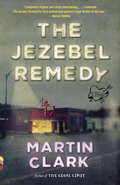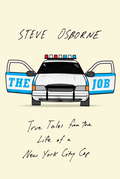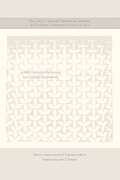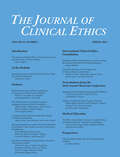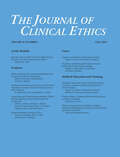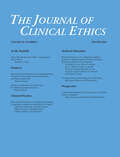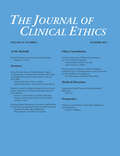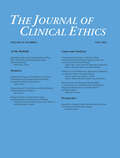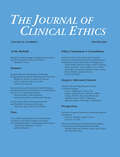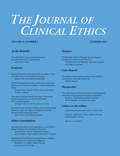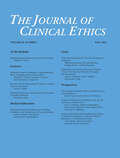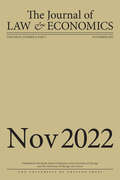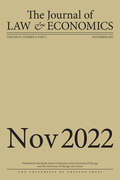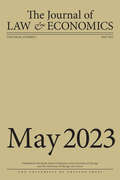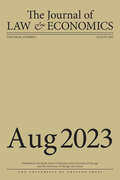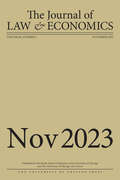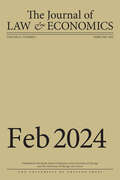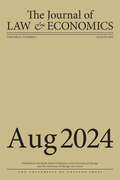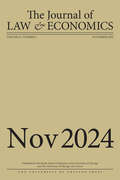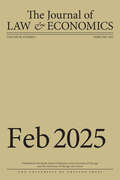- Table View
- List View
The Jezebel Remedy
by Martin ClarkMartin Clark--who has set, according to the Winston-Salem Journal, "the new standard by which other works of legal fiction should be judged"--now delivers his finest novel yet. Lisa and Joe Stone, married for twenty years and partners in their small law firm in Henry County, Virginia, handle less-than-glamorous cases, whether domestic disputes, personal injury settlements, or never-ending complaints from their cantankerous client Lettie VanSandt ("eccentric" by some accounts, "certifiable" by others). When Lettie dies in a freakish fire, the Stones think it's certainly possible that she was cooking meth in her trailer. But details soon emerge that lead them to question how "accidental" her demise actually was, and settling her peculiar estate becomes endlessly complicated. Before long, the Stones find themselves entangled in a corporate conspiracy that will require all their legal skills--not to mention some difficult ethical choices--for them to survive. Meanwhile, Lisa is desperately trying to shield Joe from a secret, dreadful error that she would give anything to erase, even as his career--and her own--hangs in the balance. In The Jezebel Remedy, Clark gives us a stunning portrait of a marriage, an intricate tour of the legal system, and a relentlessly entertaining story that is full of inventions, shocks, and understanding. This eBook edition includes a Reading Group Guide.
The Job
by Steve Osborne"HOW YA DOIN'?" With these four syllables, delivered in an unmistakably authentic New York accent, Steve Osborne has riveted thousands of people at the legendary storytelling venue The Moth (and many tens of thousands more via YouTube) with his hilarious, profane, and touching tales from his twenty years as an NYPD street cop. Steve Osborne is the real deal, people: the tough, streetwise New York cop of your dreams, one with a big, big heart. Kojak? NYPD Blue? Law & Order? Fuggedaboudem! The Job blows them out of the water. Steve Osborne has seen a thing or two in his years in the NYPD--some harmless, some definitely not. In "Stakeout," Steve and his partner mistake a Manhattan dentist for an armed robbery suspect, and reduce the man to a puddle of snot and tears when questioning him. In "Mug Shot," the mother of a suspected criminal makes a strange request and provides a sobering reminder of the humanity at stake in his profession. And in "Home," the image of Steve's family provides the adrenaline he needs to fight for his life when assaulted by two armed and violent crackheads. From stories about his days as a rookie cop to the time spent patrolling in the Anti-Crime Unit--and his visceral, harrowing recollections of working during the weeks after 9/11--The Job: True Tales from the Life of a New York City Cop captures the humanity, the absurdity, and the dark humor of police work, as well as the bravery of those who do it. These stories will speak to those nostalgic for the New York City of the 1980s and '90s, a bygone era when the city was a crazier, more dangerous (and possibly more interesting) place.From the Hardcover edition.
The John F. Sonnett Memorial Lectures at Fordham University School of Law: A Half-Century of Advocacy and Judicial Perspectives
by Dennis J. Kenny and Joel E. Davidson, EditorsThis book represents the distinguished Sonnett lecture series sponsored by Fordham’s Law School that has taken place for the last 45 years. In this collection, U.S. Supreme Court Justices, a Lord Chancellor of England, three Chief Justices of Ireland, a Chief Justice of South Africa, a President of the Supreme Court of Israel, and other leading judges and lawyers examine common law–based legal systems and underlying principles. The lectures encourage attorneys and society to improve the training of lawyers, respect the independence of the judiciary, place ethics at the forefront, question the efficacy of the criminal justice system, and explore the complex philosophical issues facing the judiciary.Taken as a whole, these lectures are a prescription for improvements and innovations throughout the legal system. The lectures were delivered by judges and lawyers who were involved in many of the most significant cases of the last half-century that strengthened individual rights and promoted access to justice. Each finds its deepest meaning in advancing the theme of Fordham Law School: “In the Service of Others.”
The Journal of Clinical Ethics, volume 34 number 1 (Spring 2023)
by The Journal of Clinical EthicsThis is volume 34 issue 1 of The Journal of Clinical Ethics. The Journal of Clinical Ethics is uniquely focused on ethical issues that arise in direct patient care, in the clinic and at the bedside, as well as with related issues and challenges in the broader practice of medicine, healthcare delivery, and best practices. The journal engages with issues of primary concern to physicians and patients—and families—and all members of the clinical team, including allied professionals in ethics consultation, as well as scholars and professionals in diverse disciplines and care-related practices: philosophy, law, theology, public and health policy, nursing, and organizational ethics.
The Journal of Clinical Ethics, volume 34 number 2 (Summer 2023)
by The Journal of Clinical EthicsThis is volume 34 issue 2 of The Journal of Clinical Ethics. The Journal of Clinical Ethics is uniquely focused on ethical issues that arise in direct patient care, in the clinic and at the bedside, as well as with related issues and challenges in the broader practice of medicine, healthcare delivery, and best practices. The journal engages with issues of primary concern to physicians and patients—and families—and all members of the clinical team, including allied professionals in ethics consultation, as well as scholars and professionals in diverse disciplines and care-related practices: philosophy, law, theology, public and health policy, nursing, and organizational ethics.
The Journal of Clinical Ethics, volume 34 number 3 (Fall 2023)
by The Journal of Clinical EthicsThis is volume 34 issue 3 of The Journal of Clinical Ethics. The Journal of Clinical Ethics is uniquely focused on ethical issues that arise in direct patient care, in the clinic and at the bedside, as well as with related issues and challenges in the broader practice of medicine, healthcare delivery, and best practices. The journal engages with issues of primary concern to physicians and patients—and families—and all members of the clinical team, including allied professionals in ethics consultation, as well as scholars and professionals in diverse disciplines and care-related practices: philosophy, law, theology, public and health policy, nursing, and organizational ethics.
The Journal of Clinical Ethics, volume 34 number 4 (Winter 2023)
by The Journal of Clinical EthicsThis is volume 34 issue 4 of The Journal of Clinical Ethics. The Journal of Clinical Ethics is uniquely focused on ethical issues that arise in direct patient care, in the clinic and at the bedside, as well as with related issues and challenges in the broader practice of medicine, healthcare delivery, and best practices. The journal engages with issues of primary concern to physicians and patients—and families—and all members of the clinical team, including allied professionals in ethics consultation, as well as scholars and professionals in diverse disciplines and care-related practices: philosophy, law, theology, public and health policy, nursing, and organizational ethics.
The Journal of Clinical Ethics, volume 35 number 1 (Spring 2024)
by The Journal of Clinical EthicsThis is volume 35 issue 1 of The Journal of Clinical Ethics. The Journal of Clinical Ethics is uniquely focused on ethical issues that arise in direct patient care, in the clinic and at the bedside, as well as with related issues and challenges in the broader practice of medicine, healthcare delivery, and best practices. The journal engages with issues of primary concern to physicians and patients—and families—and all members of the clinical team, including allied professionals in ethics consultation, as well as scholars and professionals in diverse disciplines and care-related practices: philosophy, law, theology, public and health policy, nursing, and organizational ethics.
The Journal of Clinical Ethics, volume 35 number 2 (Summer 2024)
by The Journal of Clinical EthicsThis is volume 35 issue 2 of The Journal of Clinical Ethics. The Journal of Clinical Ethics is uniquely focused on ethical issues that arise in direct patient care, in the clinic and at the bedside, as well as with related issues and challenges in the broader practice of medicine, healthcare delivery, and best practices. The journal engages with issues of primary concern to physicians and patients—and families—and all members of the clinical team, including allied professionals in ethics consultation, as well as scholars and professionals in diverse disciplines and care-related practices: philosophy, law, theology, public and health policy, nursing, and organizational ethics.
The Journal of Clinical Ethics, volume 35 number 3 (Fall 2024)
by The Journal of Clinical EthicsThis is volume 35 issue 3 of The Journal of Clinical Ethics. The Journal of Clinical Ethics is uniquely focused on ethical issues that arise in direct patient care, in the clinic and at the bedside, as well as with related issues and challenges in the broader practice of medicine, healthcare delivery, and best practices. The journal engages with issues of primary concern to physicians and patients—and families—and all members of the clinical team, including allied professionals in ethics consultation, as well as scholars and professionals in diverse disciplines and care-related practices: philosophy, law, theology, public and health policy, nursing, and organizational ethics.
The Journal of Clinical Ethics, volume 35 number 4 (Winter 2024)
by The Journal of Clinical EthicsThis is volume 35 issue 4 of The Journal of Clinical Ethics. The Journal of Clinical Ethics is uniquely focused on ethical issues that arise in direct patient care, in the clinic and at the bedside, as well as with related issues and challenges in the broader practice of medicine, healthcare delivery, and best practices. The journal engages with issues of primary concern to physicians and patients—and families—and all members of the clinical team, including allied professionals in ethics consultation, as well as scholars and professionals in diverse disciplines and care-related practices: philosophy, law, theology, public and health policy, nursing, and organizational ethics.
The Journal of Clinical Ethics, volume 36 number 1 (Spring 2025)
by The Journal of Clinical EthicsThis is volume 36 issue 1 of The Journal of Clinical Ethics. The Journal of Clinical Ethics is uniquely focused on ethical issues that arise in direct patient care, in the clinic and at the bedside, as well as with related issues and challenges in the broader practice of medicine, healthcare delivery, and best practices. The journal engages with issues of primary concern to physicians and patients—and families—and all members of the clinical team, including allied professionals in ethics consultation, as well as scholars and professionals in diverse disciplines and care-related practices: philosophy, law, theology, public and health policy, nursing, and organizational ethics.
The Journal of Clinical Ethics, volume 36 number 2 (Summer 2025)
by The Journal of Clinical EthicsThis is volume 36 issue 2 of The Journal of Clinical Ethics. The Journal of Clinical Ethics is uniquely focused on ethical issues that arise in direct patient care, in the clinic and at the bedside, as well as with related issues and challenges in the broader practice of medicine, healthcare delivery, and best practices. The journal engages with issues of primary concern to physicians and patients—and families—and all members of the clinical team, including allied professionals in ethics consultation, as well as scholars and professionals in diverse disciplines and care-related practices: philosophy, law, theology, public and health policy, nursing, and organizational ethics.
The Journal of Clinical Ethics, volume 36 number 3 (Fall 2025)
by The Journal of Clinical EthicsThis is volume 36 issue 3 of The Journal of Clinical Ethics. The Journal of Clinical Ethics is uniquely focused on ethical issues that arise in direct patient care, in the clinic and at the bedside, as well as with related issues and challenges in the broader practice of medicine, healthcare delivery, and best practices. The journal engages with issues of primary concern to physicians and patients—and families—and all members of the clinical team, including allied professionals in ethics consultation, as well as scholars and professionals in diverse disciplines and care-related practices: philosophy, law, theology, public and health policy, nursing, and organizational ethics.
The Journal of Law and Economics, volume 65 number 4 (November 2022)
by The Journal of Law and EconomicsThis is volume 65 issue 4 of The Journal of Law and Economics. Established in 1958, the Journal of Law and Economics publishes research on a broad range of topics, including the economic analysis of law, the economic analysis of regulation and the behavior of regulated firms, industrial organization and antitrust policy, the political economy of legislation and legislative processes, law and finance, and corporate finance and governance. The JLE has published some of the most influential and widely cited articles in these areas. It is an invaluable resource for academics and those interested in cutting-edge analysis of current public policy issues.
The Journal of Law and Economics, volume 65 number S2 (November 2022)
by The Journal of Law and EconomicsThis is volume 65 issue S2 of The Journal of Law and Economics. Established in 1958, the Journal of Law and Economics publishes research on a broad range of topics, including the economic analysis of law, the economic analysis of regulation and the behavior of regulated firms, industrial organization and antitrust policy, the political economy of legislation and legislative processes, law and finance, and corporate finance and governance. The JLE has published some of the most influential and widely cited articles in these areas. It is an invaluable resource for academics and those interested in cutting-edge analysis of current public policy issues.
The Journal of Law and Economics, volume 66 number 1 (February 2023)
by The Journal of Law and EconomicsThis is volume 66 issue 1 of The Journal of Law and Economics. Established in 1958, the Journal of Law and Economics publishes research on a broad range of topics, including the economic analysis of law, the economic analysis of regulation and the behavior of regulated firms, industrial organization and antitrust policy, the political economy of legislation and legislative processes, law and finance, and corporate finance and governance. The JLE has published some of the most influential and widely cited articles in these areas. It is an invaluable resource for academics and those interested in cutting-edge analysis of current public policy issues.
The Journal of Law and Economics, volume 66 number 2 (May 2023)
by The Journal of Law and EconomicsThis is volume 66 issue 2 of The Journal of Law and Economics. Established in 1958, the Journal of Law and Economics publishes research on a broad range of topics, including the economic analysis of law, the economic analysis of regulation and the behavior of regulated firms, industrial organization and antitrust policy, the political economy of legislation and legislative processes, law and finance, and corporate finance and governance. The JLE has published some of the most influential and widely cited articles in these areas. It is an invaluable resource for academics and those interested in cutting-edge analysis of current public policy issues.
The Journal of Law and Economics, volume 66 number 3 (August 2023)
by The Journal of Law and EconomicsThis is volume 66 issue 3 of The Journal of Law and Economics. Established in 1958, the Journal of Law and Economics publishes research on a broad range of topics, including the economic analysis of law, the economic analysis of regulation and the behavior of regulated firms, industrial organization and antitrust policy, the political economy of legislation and legislative processes, law and finance, and corporate finance and governance. The JLE has published some of the most influential and widely cited articles in these areas. It is an invaluable resource for academics and those interested in cutting-edge analysis of current public policy issues.
The Journal of Law and Economics, volume 66 number 4 (November 2023)
by The Journal of Law and EconomicsThis is volume 66 issue 4 of The Journal of Law and Economics. Established in 1958, the Journal of Law and Economics publishes research on a broad range of topics, including the economic analysis of law, the economic analysis of regulation and the behavior of regulated firms, industrial organization and antitrust policy, the political economy of legislation and legislative processes, law and finance, and corporate finance and governance. The JLE has published some of the most influential and widely cited articles in these areas. It is an invaluable resource for academics and those interested in cutting-edge analysis of current public policy issues.
The Journal of Law and Economics, volume 67 number 1 (February 2024)
by The Journal of Law and EconomicsThis is volume 67 issue 1 of The Journal of Law and Economics. Established in 1958, the Journal of Law and Economics publishes research on a broad range of topics, including the economic analysis of law, the economic analysis of regulation and the behavior of regulated firms, industrial organization and antitrust policy, the political economy of legislation and legislative processes, law and finance, and corporate finance and governance. The JLE has published some of the most influential and widely cited articles in these areas. It is an invaluable resource for academics and those interested in cutting-edge analysis of current public policy issues.
The Journal of Law and Economics, volume 67 number 2 (May 2024)
by The Journal of Law and EconomicsThis is volume 67 issue 2 of The Journal of Law and Economics. Established in 1958, the Journal of Law and Economics publishes research on a broad range of topics, including the economic analysis of law, the economic analysis of regulation and the behavior of regulated firms, industrial organization and antitrust policy, the political economy of legislation and legislative processes, law and finance, and corporate finance and governance. The JLE has published some of the most influential and widely cited articles in these areas. It is an invaluable resource for academics and those interested in cutting-edge analysis of current public policy issues.
The Journal of Law and Economics, volume 67 number 3 (August 2024)
by The Journal of Law and EconomicsThis is volume 67 issue 3 of The Journal of Law and Economics. Established in 1958, the Journal of Law and Economics publishes research on a broad range of topics, including the economic analysis of law, the economic analysis of regulation and the behavior of regulated firms, industrial organization and antitrust policy, the political economy of legislation and legislative processes, law and finance, and corporate finance and governance. The JLE has published some of the most influential and widely cited articles in these areas. It is an invaluable resource for academics and those interested in cutting-edge analysis of current public policy issues.
The Journal of Law and Economics, volume 67 number 4 (November 2024)
by The Journal of Law and EconomicsThis is volume 67 issue 4 of The Journal of Law and Economics. Established in 1958, the Journal of Law and Economics publishes research on a broad range of topics, including the economic analysis of law, the economic analysis of regulation and the behavior of regulated firms, industrial organization and antitrust policy, the political economy of legislation and legislative processes, law and finance, and corporate finance and governance. The JLE has published some of the most influential and widely cited articles in these areas. It is an invaluable resource for academics and those interested in cutting-edge analysis of current public policy issues.
The Journal of Law and Economics, volume 68 number 1 (February 2025)
by The Journal of Law and EconomicsThis is volume 68 issue 1 of The Journal of Law and Economics. Established in 1958, the Journal of Law and Economics publishes research on a broad range of topics, including the economic analysis of law, the economic analysis of regulation and the behavior of regulated firms, industrial organization and antitrust policy, the political economy of legislation and legislative processes, law and finance, and corporate finance and governance. The JLE has published some of the most influential and widely cited articles in these areas. It is an invaluable resource for academics and those interested in cutting-edge analysis of current public policy issues.
